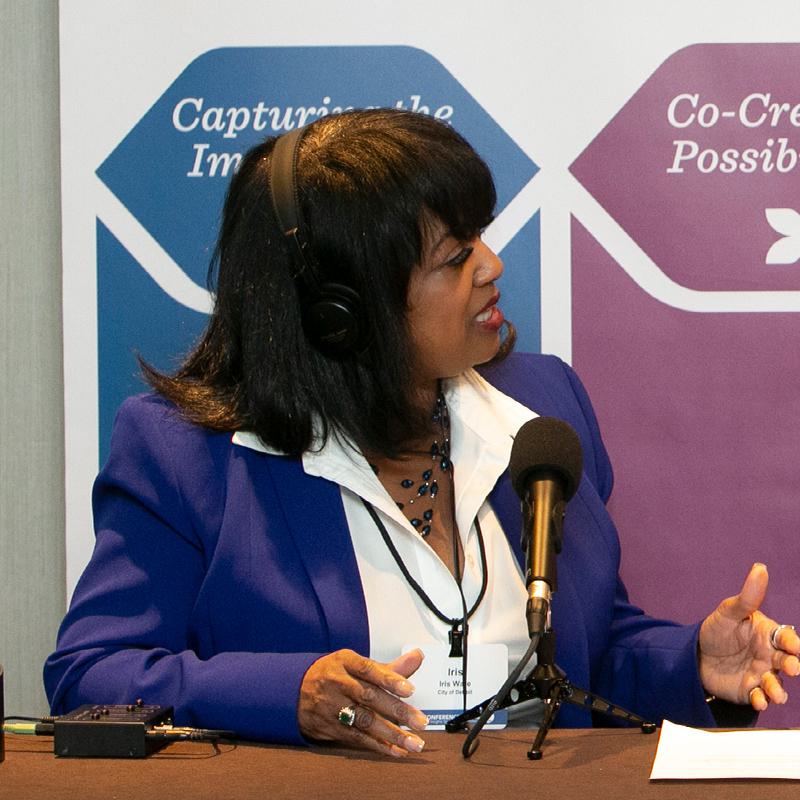At The Conference Board’s 16th annual conference on Change and Transformation, Maril Gagen MacDonald interviewed Iris Ware, PhD, Chief Learning Officer for the City of Detroit. What follows is a condensed transcript of their conversation.
Fast Facts
Location::
Detroit, MI
Number of Employees::
9,000
Time in Current Role::
4 years
Questions & Answers
The City of Detroit is a wonderful example of transformation. Tell me about the work you’re doing there.:
IW: I have to admit, I’m having a lot of fun. As Chief Learning Officer for the City of Detroit, my responsibility is to provide training and development, as well as performance management, for all city employees—currently totaling 9,000.
Prior to my arrival four years ago, no training development or performance management had been conducted for about six years, so we basically started at ground zero.
That’s a big undertaking and brings to mind the idea of using instructional design to achieve your goals. Thinking about this approach, how would you use leadership as a design mechanism?:
IW: The concept of instructional design focuses on creating materials that facilitate learning, and there are many methodologies and strategies about adult learning and how people acquire and embrace information.
At this conference, we’ve heard many conversations about alignment. That really excites me because we need to think about how we provide information that enables leaders to build on their core competencies, embrace alignment, and focus on the why. That can make the difference between just shifting an organization and changing it.
This interview series is called Let Go & Lead because it addresses the evolving necessity of leading when you're no longer in control. How do you think about this concept?:
IW: The concept of “Let Go & Lead” is extremely timely. Many leadership models and theories explore how to lead and guide people. The thing is, the concept of leadership is simply getting people to willingly follow and support the organization’s opportunities and objectives.
As the late Benjamin Hooks, former director of the NAACP, said, “If you think you are leading and turn around to see no one following, then you are just taking a walk.” We find many times that people are just taking that walk. But if you embrace the needs of employees, if you understand the strategic objectives of the organization, and if you lead from your heart, you can impact an organization.
If you're that man or woman “taking a walk” and no one's behind you when you turn around, what do you do?:
IW: You need to turn around quickly and find out where everyone is. Evidently, they’ve found something more important to do or something more necessary or challenging than the objectives and strategies you’re asking them to follow. The first thing you have to do is explain why they need to do what you’re asking them to do and where [the team is going].
Over the years, I’ve seen many design theories about being authentic, but one of the things I found to be most impactful is situational leadership. It’s really just understanding where people are and whether they’re willing, ready and able to follow. Then, it requires addressing their needs and clearly explaining the why and what’s in it for them.
People commit to things they believe in and understand. The leader’s role is to make sure people believe in what they’re doing and understand their roles. Then, the leader provides them with the tools and resources they need to succeed.
What do you see as the most critical competencies leaders need today?:
IW: Leaders need to be extremely flexible and open. Sometimes when people reach a certain level of leadership in their careers, they tend to create a dictatorship or monarchy. If that’s your approach, you’ll be a person just taking a walk. Leaders need to be open and flexible to the exchange of information and the exchange of ideas.
Great leaders also use strength-based assignments. I focus on people’s strengths and coordinate their work based on those instead of attempting to close large gaps, which often wastes time and money. For instance, I’m terrible with directions. I’ll get lost standing in front of my house if you spin me around a few times. It’d be a waste of time trying to teach me how to navigate, so I’ll just buy a GPS instead.
I find it works in almost any situation to match people to projects based on their strengths and what they love to do rather than working to close extensive gaps. The trick is finding people whose strengths fill out your gaps as a leader.
Leaders also need to understand that your greatest strength can be your greatest weakness if you overdo it. Too much of anything isn’t good for you.
One of my favorite tenets is that the overused strength—or, as Marshall Goldsmith would say: adding too much value—is a killer.:
IW: As I tell my team, you don’t need a chainsaw to carve a turkey. You can use one if you want, but that’s not the best use of its capabilities.
What do you think leaders most need to let go of?:
IW: Control. Steve Jobs said, ’It doesn’t make sense to hire smart people and tell them what to do; we hire smart people so they can tell us what to do.” Great leaders let go of control.
’
Join us at The Conference Board’s Change is the Only Constant: How to Communicate It and Win seminar on December 11-12 in New York City to explore more concepts like these from today’s leading change agents.
